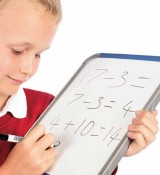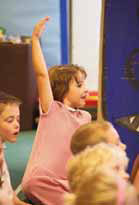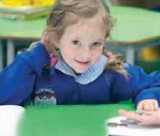Effective maths assessment means finding out how children arrive at their answers and, if they get lost, setting them on the right path
Forget official tests and endless tick-sheets. Assessing children’s mathematical learning is something that teachers do as part of their classroom work, whether noting answers to questions, marking books or observing practical activities. These scenarios are familiar, but mathematical assessment also happens in unlikely places.
There is an old TV clip on YouTube called ‘Baldrick tries advanced mathematics’ in which he is given two sets of beans and asked what that makes (tinyurl.com/y2dvcg9). His answer, ‘a very small casserole’ reminds us how important the wording can be when asking mathematical questions. Fortunately the correct numerical answer is also given, though only when the conversation has moved on to something else. Most teachers know it pays to wait for an answer and strategies for doing this often also encourage all children to respond.
 No, I don’t mean the all-singing all-dancing interactive whiteboards and all the accompanying technology. My enthusiasm is directed more towards the small whiteboards that children use for writing their answers on and holding up at a specified time. This practice has gone some way to reducing timehonoured classroom rituals such as the same people always having their hands up, others never answering and the really inventive trying to put their hand up at such a time that it is too late for them to be asked but they might still get some credit. Not that whiteboards are the whole answer, no single object is. I have seen children calculating on whiteboards, rubbing the answers off, then being asked to assess their own performance. This can be successful, but it is possible for a child to feel confident in their calculation when they are actually displaying a systematic error . There is still a place for teachers looking at children’s written mathematics and making their own judgements.
No, I don’t mean the all-singing all-dancing interactive whiteboards and all the accompanying technology. My enthusiasm is directed more towards the small whiteboards that children use for writing their answers on and holding up at a specified time. This practice has gone some way to reducing timehonoured classroom rituals such as the same people always having their hands up, others never answering and the really inventive trying to put their hand up at such a time that it is too late for them to be asked but they might still get some credit. Not that whiteboards are the whole answer, no single object is. I have seen children calculating on whiteboards, rubbing the answers off, then being asked to assess their own performance. This can be successful, but it is possible for a child to feel confident in their calculation when they are actually displaying a systematic error . There is still a place for teachers looking at children’s written mathematics and making their own judgements.
 This is probably an older joke than Blackadder, but for those who haven’t heard it, the idea is that a pupil misinterprets the test instruction ‘show your working’ and uses the box provided to draw a picture of themselves hunched over a table and scribbling furiously. The idea of showing working is not without dangers, but the basic idea is helpful as we can learn a lot more from looking at how children have approached a mathematical problemthan from simply looking at the answer.
This is probably an older joke than Blackadder, but for those who haven’t heard it, the idea is that a pupil misinterprets the test instruction ‘show your working’ and uses the box provided to draw a picture of themselves hunched over a table and scribbling furiously. The idea of showing working is not without dangers, but the basic idea is helpful as we can learn a lot more from looking at how children have approached a mathematical problemthan from simply looking at the answer.
Questions which are open and investigative offer children the opportunity to use and record a range of strategies and as well as these being informative to the teacher, they also offer the opportunity for children to share their methods with each other. Inefficient or incorrect strategies can also be a powerful starting point for discussion. Sometimes, written errors in maths books can signal that action is required
Jason was asked to carry out addition using an open number line following a method demonstrated to his Y3 class. Jason drew several number lines in his maths book, but appeared not to understandthe relative position of numbers. E.g. he marked 56 before 40. The first question for Jason’s teacher might be whether or not this is an isolated slip and this can be answered by asking him to mark a few more numbers on other lines. If the difficulty is confirmed, the teacher might revisit empty number lines, or encourage this child to use a different method of calculation.
Scenes from a shop
Observation of practical activities, often accompanied by listening to the child, can also be informative. Those working with young children capture such activities in a range of ways, perhaps using photographs and narrative accounts to record key events or sometimes making an informal note on a Post-it
 Angela was attempting to find the total value of two coins, a 20p and a 1p, which she had been given in her role as ‘shopkeeper’ in a Y1 class shop. She touched the 20p coin 20 times, saying the numbers 1 to 20 as she did so and then touched the 1p coin and said 21. She proudly announced the correct answer of 21p.
Angela was attempting to find the total value of two coins, a 20p and a 1p, which she had been given in her role as ‘shopkeeper’ in a Y1 class shop. She touched the 20p coin 20 times, saying the numbers 1 to 20 as she did so and then touched the 1p coin and said 21. She proudly announced the correct answer of 21p.
Angela showed great perseverance and reached a correct answer. Neverthelessm, there are more effective and less time-consuming ways to do this calculation and I certainly would not like to be behind Angela in a shop when she tries to total the value of a handful of 50p coins. The decision now for an adult is whether it is appropriate to start to move Angela on to a different method for this calculation and how this might best be done.
Magic moments
We often assess mathematics by noting children’s answers, right or wrong, and their methods. A challenge is also to go beyond calculation and see if we can recognise and record processes such as reasoning and generalising. Not everything that happens in a busy classroom can be recorded, but one of the key aims of classroom assessment is to capture moments that are significant. Sometimes these are moments to celebrate, as in the next example.
A year five maths group were exploring the properties of 2D shapes in a lesson which star ted by them being asked to draw round and cut out various shapes. The teacher turned the discussion to lines of symmetry; this was straightforward for many who had cut polygons, but more challenging for Sean who was holding a circle. Sean surprised the adults by announcing ‘It can go anywhere, any line in the circle.’
Sean’s comment shows understanding of circles and of line symmetry together with the ability to make a succinct general statement. It is worth adding that Sean was considered to be a low attainer in mathematics. He would have had difficulty in writing this statement down, so the role of an adult in hearing it and seeing it as important was key. This was seen as a moment of achievement rather than one for questions, but an exploration of what Sean meant by ‘any line’ would have established whether he realised that lines of symmetry had to go through the centre of the circle. Part of the art of assessment is asking the right follow-up questions. There is a magic moment in another of my YouTube favourites, called Paddington Bear on a game show (http://www.tinyurl.com/4yuflca). This is worth watching, not just for a reminder of the days when TV presenters wore pink flares and £100 was a lot of money. It reminds us that it is always worth exploring unexpected answers, that real-life contexts are not always what they seem and that the answer in our head may not be the only one.
Jenny Houssart is Reader in education at the Institute of Education, University of London (ioe.ac.uk). Her book, Supporting Mathematical Thinking is available from David Fulton.
Reorganise your music room
Ace-Music
Make every lesson an experiment
Cross Curricular
